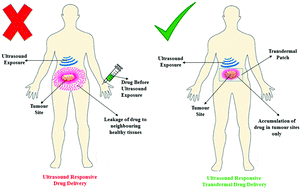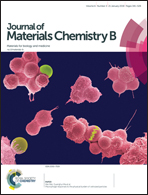Temperature and ultrasound sensitive gatekeepers for the controlled release of chemotherapeutic drugs from mesoporous silica nanoparticles†
Abstract
With the advent of smart biomaterials, environmental stimuli have always been the trigger for targeted drug delivery. Conventional routes of drug administration suffer from serious drawbacks like first pass metabolism, less patient compliance and the requirement of trained personnel. Of the many well-established non-conventional routes, transdermal drug delivery systems (TDDSs) seem to be promising as they do not enter directly into the bloodstream and hence, side effects can significantly be reduced. Researchers around the world are trying to incorporate environmental sensitivity into TDDSs. Herein, we report the design and fabrication of a dual sensitive TDDS: (tetrahydropyranyl methacrylate-co-amino ethyl methacrylate)-grafted-mesoporous silica nanoparticles, (THPMA-co-AEMA)-g-MSNs, that could simultaneously sense temperature and an external stimulus – ultrasound (US). Temperature sensitivity was imparted by the conformational changes adopted by the system above and below the lower critical solution temperature (LCST). Below the LCST (4 °C), the polymer would exist as linear chains allowing drug molecules to enter the mesopores of silica, and at physiological temperatures the copolymer collapses preventing premature drug leakage. This sensitivity could be complemented by the inclusion of mechanophores like tetrahydropyran (THP), which could cleave bonds on exposure to US. At physiological temperatures, the TDDS can be placed at malignant sites and on US exposure, the chemotherapeutic agents could be leached out, resulting in better targeting, efficient drug release and minimal side effects. US can act as a potential penetration enhancer making it ideal even for targeting internal organs. All reaction procedures were monitored with the aid of FTIR, XRD, 1H NMR and FE-SEM techniques. Temperature sensitivity was analysed by encapsulating 5-flurouracil (5-FU) and analysing with a UV-Visible spectrophotometer. US sensitivity was monitored as a function of scattering light intensity. Pore opening and closure was verified by nitrogen adsorption isotherms. The dual responsiveness of the material was confirmed by confocal images of the sample before and after exposure to US. The physiological acceptance and practical efficacy of the material in real life situations were confirmed by histological studies on rat skin, MTT assay in HeLa cell lines and in vivo CAM assay. The results suggest the potential applicability of the material in site selective transdermal delivery of chemotherapeutic drugs.



 Please wait while we load your content...
Please wait while we load your content...